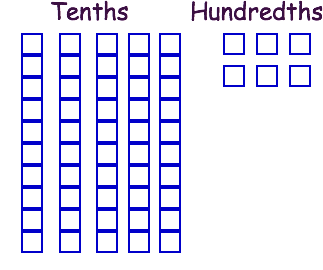All Common Core: 5th Grade Math Resources
Example Questions
Example Question #21 : Add, Subtract, Multiply, And Divide Decimals To Hundredths: Ccss.Math.Content.5.Nbt.B.7
Subtract:
We can use base ten blocks to help us solve this problem. Let's review what our base ten blocks are by using a whole number

When we put this together, we add:
To use base ten blocks to add decimal numbers, we need to think of the base ten blocks a little differently. We think of the hundreds block as one whole. The tens block as tenths because you would need ten of these to make one whole. Finally, the ones block as hundredths because you would need a hundred of these to make one whole:

Let's look at this problem:
First, we want to represent the 

Next, we want to take away 

We can see that we now have three tenths blocks and four hundredths blocks, which means our answer is

Example Question #22 : Add, Subtract, Multiply, And Divide Decimals To Hundredths: Ccss.Math.Content.5.Nbt.B.7
Subtract the following:
We can use base ten blocks to help us solve this problem. Let's review what our base ten blocks are by using a whole number

When we put this together, we add:
To use base ten blocks to add decimal numbers, we need to think of the base ten blocks a little differently. We think of the hundreds block as one whole. The tens block as tenths because you would need ten of these to make one whole. Finally, the ones block as hundredths because you would need a hundred of these to make one whole:

Let's look at this problem:
First, we want to represent the 

Next, we want to take away 

We can see that we now have two tenths blocks and one hundredths block, which means our answer is

Example Question #1 : Subtract Decimals
Subtract:
Subtracting decimals is just like subtracting regular numbers. But, you must remember your decimal in your answer:
Example Question #2 : Subtract Decimals
Subtract:
Subtracting decimals is just like subtracting regular numbers. But, you must remember your decimal in your answer:
Example Question #3 : Subtract Decimals
Subtract:
Subtracting decimals is just like subtracting regular numbers. But, you must remember your decimal in your answer:
Example Question #6 : Subtract Decimals
Subtract:
We can use base ten blocks to help us solve this problem. Let's review what our base ten blocks are by using a whole number

When we put this together, we add:
To use base ten blocks to add decimal numbers, we need to think of the base ten blocks a little differently. We think of the hundreds block as one whole. The tens block as tenths because you would need ten of these to make one whole. Finally, the ones block as hundredths because you would need a hundred of these to make one whole:

Let's look at this problem:
First, we want to represent the 

Next, we want to take away 

We can see that we now have one tenths block and three hundredths blocks, which means our answer is

Example Question #3 : Subtract Decimals
Subtracting decimals is just like subtracting whole numbers. But, you must remember your decimal in your answer.
You start subtracting on the far right which in this case is the hundredths place. You cannot take 






Next, subtract the tenths place. 
The decimal will be carried down and remain between the tenths place and the ones place. 
The final subtraction portion is the ones place. 
The final answer is
Example Question #701 : Number & Operations In Base Ten
Subtracting decimals is just like subtracting whole numbers. But, you must remember your decimal in your answer.
You start subtracting on the far right which in this case is the hundredths place. 
Next, subtract the tenths place 
The decimal will be carried down and remain between the tenths place and the one' place. 
The final subtraction portion is the ones place. 
Example Question #702 : Number & Operations In Base Ten
Subtracting decimals is just like subtracting whole numbers. But, you must remember your decimal in your answer.
You start subtracting on the far right which in this case is the hundredths place. 
Next, subtract the tenths place. 
The decimal will be carried down and remain between the tenths place and the ones place. 
The final subtraction portion is the ones place. 
The final answer is
Example Question #703 : Number & Operations In Base Ten
Subtracting decimals is just like subtracting whole numbers. But, you must remember your decimal in your answer.
You start subtracting on the far right which in this case is the hundredths place. 
Next, subtract the tenths place. You cannot take 






The decimal will be carried down and remain between the tenths place and the ones place. 
The final subtraction portion is the ones place. 
The final answer is
Certified Tutor
Certified Tutor
All Common Core: 5th Grade Math Resources

![\frac{\begin{array}[b]{r}.45\\ -\ .11\end{array}}{\ \ \ \ }](http://cdn-s3.varsitytutors.com/uploads/formula_image/image/1087662/gif.latex)







![\frac{\begin{array}[b]{r}.45\\ +\ .13\end{array}}{\ \ \ \ }](https://cdn-s3.varsitytutors.com/uploads/formula_image/image/1087572/gif.latex)

![\frac{\begin{array}[b]{r}.56\\ -\ .35\end{array}}{\ \ \ \ }](http://cdn-s3.varsitytutors.com/uploads/formula_image/image/1087679/gif.latex)







![\frac{\begin{array}[b]{r}.56\\ -\ .35\end{array}}{\ \ \ \ }](http://cdn-s3.varsitytutors.com/uploads/formula_image/image/1087680/gif.latex)

![\frac{\begin{array}[b]{r}.35\\ -\ .13\end{array}}{\ \ \ \ }](http://vt-vtwa-assets.varsitytutors.com/vt-vtwa/uploads/formula_image/image/1170402/gif.latex)




![\frac{\begin{array}[b]{r}.35\\ -\ .13\end{array}}{\ \ \ \ }](http://vt-vtwa-assets.varsitytutors.com/vt-vtwa/uploads/formula_image/image/1170403/gif.latex)

![\frac{\begin{array}[b]{r}.83\\ -\ .13\end{array}}{\ \ \ \ }](http://vt-vtwa-assets.varsitytutors.com/vt-vtwa/uploads/formula_image/image/1170408/gif.latex)




![\frac{\begin{array}[b]{r}.83\\ -\ .13\end{array}}{\ \ \ \ }](http://vt-vtwa-assets.varsitytutors.com/vt-vtwa/uploads/formula_image/image/1170409/gif.latex)

![\frac{\begin{array}[b]{r}.57\\ -\ .23\end{array}}{\ \ \ \ }](http://vt-vtwa-assets.varsitytutors.com/vt-vtwa/uploads/formula_image/image/1170430/gif.latex)




![\frac{\begin{array}[b]{r}.57\\ -\ .23\end{array}}{\ \ \ \ }](http://vt-vtwa-assets.varsitytutors.com/vt-vtwa/uploads/formula_image/image/1170431/gif.latex)

![\frac{\begin{array}[b]{r}.15\\ -\ .02\end{array}}{\ \ \ \ }](http://cdn-s3.varsitytutors.com/uploads/formula_image/image/1087675/gif.latex)







![\frac{\begin{array}[b]{r}.15\\ -\ .02\end{array}}{\ \ \ \ }](http://cdn-s3.varsitytutors.com/uploads/formula_image/image/1087676/gif.latex)

![\frac{\begin{array}[b]{r}3.35\\ -\ 1.16\end{array}}{\ \ \ \ }](http://vt-vtwa-assets.varsitytutors.com/vt-vtwa/uploads/formula_image/image/1177826/gif.latex)





![\frac{\begin{array}[b]{r}3.45\\ -\ 1.13\end{array}}{\ \ \ \ }](http://vt-vtwa-assets.varsitytutors.com/vt-vtwa/uploads/formula_image/image/1177814/gif.latex)





![\frac{\begin{array}[b]{r}1.79\\ -\ .14\end{array}}{\ \ \ \ }](http://vt-vtwa-assets.varsitytutors.com/vt-vtwa/uploads/formula_image/image/1177834/gif.latex)





![\frac{\begin{array}[b]{r}9.17\\ -\ 4.24\end{array}}{\ \ \ \ }](http://vt-vtwa-assets.varsitytutors.com/vt-vtwa/uploads/formula_image/image/1177846/gif.latex)








